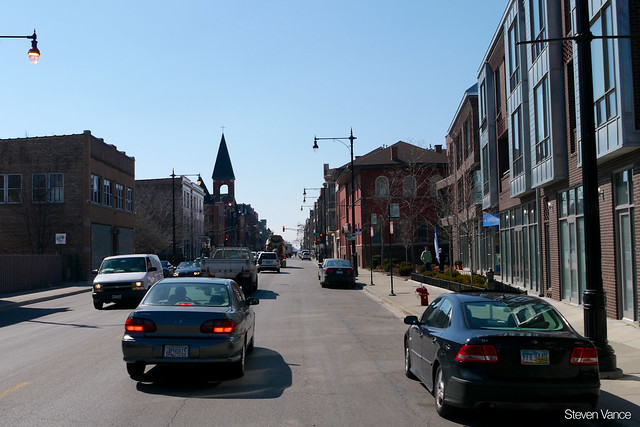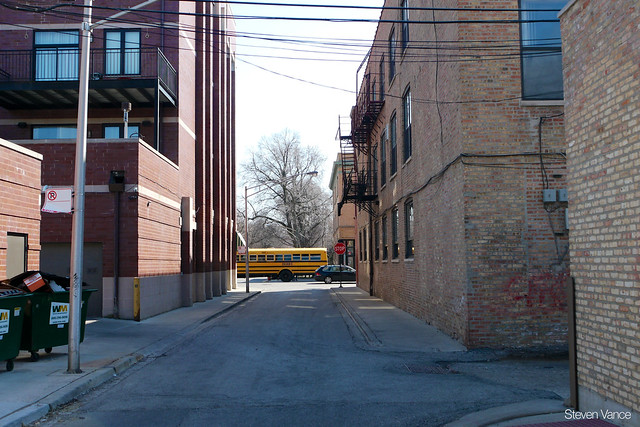Rush hour parking controls, which ban parking on one side of a street during the morning and evening rush so more traffic can flow in the peak direction, are incompatible with most if not all types of bike lanes.
A few months ago, the Chicago Department of Transportation did away with rush hour parking controls on North Avenue between Ashland Avenue and Western Avenue, increasing pedestrian safety and clearing the way for bike lanes. It remains to be seen, however, whether the city will add them.
John Paige owns Urban Planning Services, a consulting firm, on this stretch of North Avenue and says he had talked to deputy commissioner Luann Hamilton at the Chicago Department of Transportation about removing the parking restrictions. The signs disappeared "without any fanfare," he said, in October 2012.
Paige likes how the cars parked along the curb create a buffer between traffic and people on the sidewalk. He also likes how the increased availability of parking has led fewer drivers to park on the sidewalk at Hoyne Avenue, where gym customers used to deposit their cars.
Why the seemingly sudden but welcome change? According to CDOT, Alderman Waguespack (32nd ward) asked CDOT to look at pedestrian safety near North and Hoyne Avenue. Hamilton wrote to Streetsblog:
Traffic engineering staff and the pedestrian program coordinator visited the corridor and noted the peak hour restrictions along the corridor from Ashland to Western. After analyzing these restrictions, which were established in 1993, the traffic engineers determined that they were ineffective and could be eliminated. Coincidentally, in October 2011, Alderman Moreno requested removal of PM peak hour restrictions on the south side of North Avenue between Ashland and Damen to support the business community's request for additional parking hours. CDOT combined these requests and reached out to the two aldermen to propose removing parking on both sides of the street from Western to Ashland to improve the pedestrian environment.
If parked vehicles obstruct the peak hour restriction lanes on a regular basis, instead of getting added capacity at peak times, you get bottlenecks at the locations where vehicles using the lane have to merge into the 24-7 travel lane and then merge back into the peak hour lane. This presents pedestrians with a less predictable situation [of] how vehicles will operate in the corridor during peak times. To provide a consistent pedestrian experience in this heavily used pedestrian corridor, we recommended [their] removal.
At about 48 feet wide between Ashland and Damen Avenue, and 51 feet wide between Damen and Western, these segments of North Avenue have sufficient width for a bike lane and a buffered bike lane, respectively. However, the Streets for Cycling Plan 2020 doesn't identify any part of North Avenue as getting a bikeway. North Avenue is under IDOT jurisdiction, but that shouldn't be an obstacle to these types of bike lanes. While the agency stubbornly refuses to add protected bike lanes to its streets, painted bike lanes have been installed on state roads, including Jackson Boulevard, where IDOT prevented CDOT from installing a protected lane.
There are many more streets with rush hour parking controls that similarly prevent the implementation of bike lanes. California Avenue between Fullerton Avenue and Kennedy Expressway in Logan Square and Avondale comes to mind as do Diversey and Belmont Avenues between Kimball Avenue and Western Avenue. We'll be looking into whether CDOT plans to remove rush hour parking controls from other streets.







